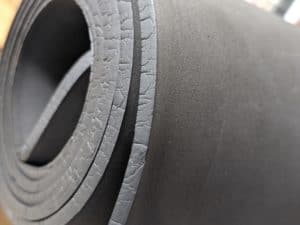
Closed Cell Sponge/Foam rubber materials have a place in the industry. Oftentimes they are used in applications where either for vibration dampening, or gasketing where not much compression force is available. However, there are also times where the environmental requirements of an application require a blend of properties. These times there is one sponge meets most of the requirements and another sponge meets most of the requirements, but there is a need for something in the middle. In those applications oftentimes a closed cell sponge blend is required. These materials oftentimes are mixed to meet certain specifications.
Elastomers Available of Sponge Blends
Typically when we discuss blends of closed cell sponge/foam products we are talking about 4 elastomer types that are mixed, and matched. These 5 elastomers can be mixed, and matched a few ways.
| Elastomers/Polymers Available |
| PVC/NBR |
| EPDM/CR/SBR |
| PVC/NBR/CR |
| CR/EPDM |
CR= Neoprene
EPDM= Ethylene Propylene Diene Monomer
PVC= Polyvinyl Chloride
SBR= Styrene Butadiene Rubber
NBR= Nitrile Butadiene Rubber
One thing to keep in mind, some of these elastomers can cause issues in an application. In cases such as those, it may be a good idea to exclude some of these materials from an application. In those cases, look for 100% of a polymer, such as 100% Neoprene, or 100% EPDM foam.
Why look for a Sponge Blend?
A. Properties: The obvious answer is the mixture of properties. For example, Some blends EPDM/CR/SBR meet a number of mid-grade requirements of oil swell, as well as low-temperature requirements.
B. Specifications: Sponge materials are able to meet a number of specifications. Take SCE41B for example. This sponge material meets:
-ASTM D1056 2A1
-ASTM D6576 TYPE II A/B/C SOFT
-MIL-R-6130 TYPE II GRADE A SOFT
-MIL-C-3133/MIL-STD-670 SCE3
-UL-94-HF-1, LISTED
C. Cost: The mixture of materials enables for some of the expensive polymers to be diluted with less expensive polymers.
Thicknesses/Availability of Sponge Blends
These cellular sponges are manufactured out of buns. This offers a few advantages:
- Custom thicknesses are often available typically at no extra charge. In the rubber industry, solid rubber products are usually calendered to thickness. Once the materials are available in bun form, they can be skived to the particular thickness required.
- Thick materials are no problem to procure, as these materials are originally made out of thick buns to begin with.
More Information
NEDC provides rubber blend parts die-cut, and waterjet cut. In addition, these materials can be laminated as well. For more information on sponge blends, or sponge/foam gaskets please contact sales@nedc.com.